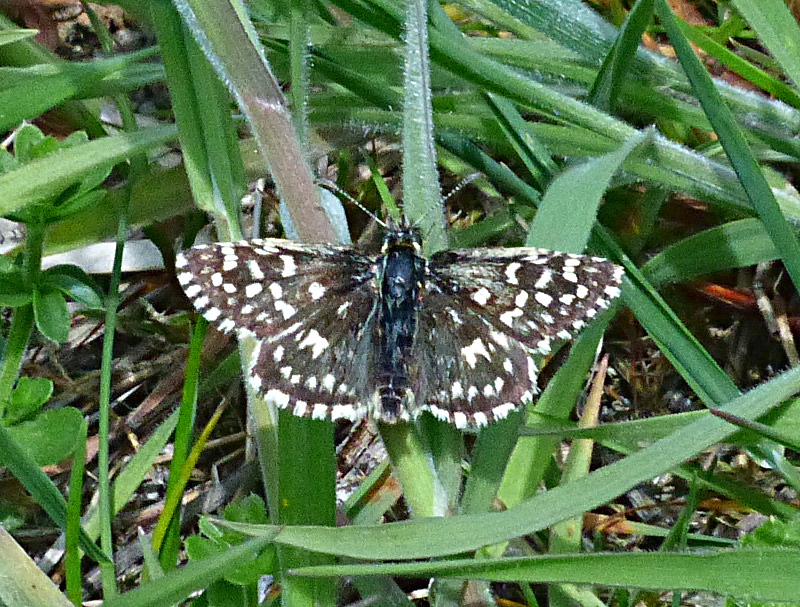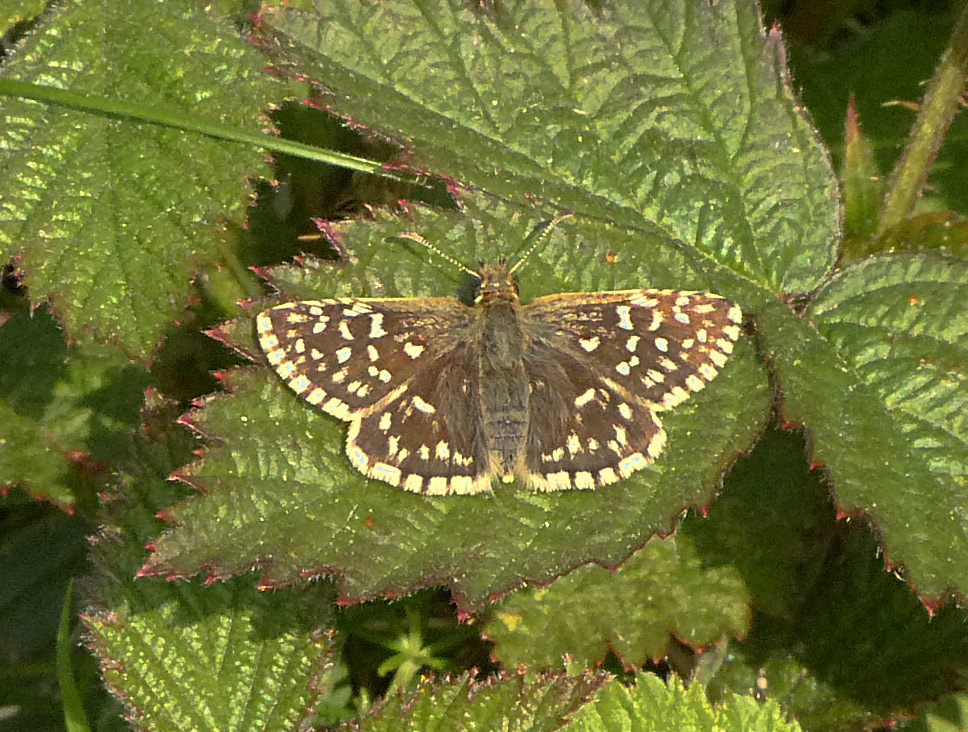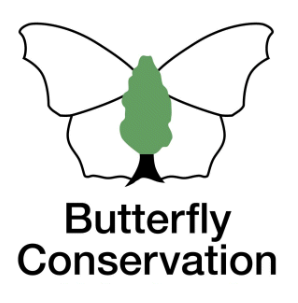Brown Argus
Brown Hairstreak
Chalkhill Blue
Clouded Yellow
Comma
Common Blue
Dark Green Fritillary
Dingy Skipper
Essex Skipper
Gatekeeper
Green Hairstreak
Green-veined White
Grizzled Skipper
Holly Blue
Large Skipper
Large White
Marbled White
Meadow Brown
Orange-tip
Painted Lady
Peacock
Purple Emperor
Purple Hairstreak
Red Admiral
Ringlet
Silver-washed Fritillary
Small Blue
Small Copper
Small Heath
Small Skipper
Small Tortoiseshell
Small White
Speckled Wood
Wall
White Admiral
White-letter Hairstreak
Extinct/rare immigrants
Grizzled Skipper
Pyrgus malvae
General Distribution and Status
The Grizzled Skipper is now found in central and southern England but historically it was found in Scotland where it became extinct in the 19th century. The decline accelerated in the last century, more particularly since the 1950s due to destruction of semi-natural grassland and cessation of woodland coppicing. Conservation measures such as coppicing and grazing have helped restore populations. Many habitats rely on rabbit grazing to maintain suitable mosaics (Asher et al.). The last ten years or so have seen a stabilisation of distribution across the country (Fox et al.) but abundance has more than halved although there was a slight increase since 2018. A similar situation arises in Hertfordshire and Middlesex although no apparent increase in abundance occurred in the last few years.
| United Kingdom | Herts & Middx | |||
| Distribution | 1976-2019 | -48% | 1980-2015 | -72% |
| Average 10-year trend | -13% | 2006-2015 | -15% | |
| 2024 since 2015-19 | 0% | |||
| Abundance | 1976-2024 | -49% | 1980-2015 | +970% |
| 2015-2024 | -5% | 2006-2015 | +21% | |
| 2023-2024 | -20% | 2024 since 2015-19 | -38% | |
UK distribution map
UKBMS Species summary
Habitat Requirements
The Grizzled Skipper favours sheltered spots on flower-rich grassland on chalk slopes, roadside verges, woodland clearings, railway embankments and disused industrial sites.
Larval Foodplants
Wild Strawberry Fragaria vesca, Agrimony Agrimonia eupatoria, Creeping Cinquefoil Potentilla reptans. Barren Strawberry P. sterilis, Tormentil P. erecta, Silverweed P. anserina, Raspberry Rubus idaeus and Bramble R. fruticosus are also sometimes used (Sawford).
Adult Food Sources
Common Birds-foot Trefoil Lotus corniculatus (25), Dandelion Taraxacum sp. (22), Buttercup Ranunculua sp. (17).
Historical Records
Durrant reported it from Knebworth sometime before 1902 according to Gibbs' survey. Palmer saw some in May 1922, May 1923 and May 1925 in Knebworth Woods (Sawford). It was still quite common there in 1948 when Ferry captured 12 specimens on 25 April. In the 1940s it was 'not uncommon on open scrub and rough grassland flanking St. John's Wood, east of Walkern' (Birdsall). Numbers declined significantly by the 1980s as indicated by Waterton in his 1970-81 survey; 'now much scarcer, but this is more likely due to climatic change as its food-plants, bramble and wild strawberry are still common' although Ferry spotted the butterfly in Knebworth Park on the north-western corner in 1976-77 and I found one on Bandley Hill near Aston on a warm, sunny evening on 3 June 1980.
Local Distribution and Abundance
The Grizzled Skipper occurs only on Frogmore Gravel Pit although it is possible it is found elsewhere, for example, at Knebworth Park where it existed in the past. One record was submitted by Tony Hukin for 2 specimens found near Watery Grove on 14 June 1996. The best year to date was 2013 when 91 were counted and although there has been an increase in numbers recorded since 2010 more visits were made to the pit so to depict an abundance chart highlighting a trend may give a misleading picture. Only three visits were made to the Frogmore Gravel Pit in 2020 due to Covid restrictions, all in May, when peak numbers had already passed. However, good numbers were reported in 2021. Only report in both 2022 and 2023 made to the pit producing counts of 19 and six respectively. The main areas of the pit are becoming more inaccessible because of flooding. Predominantly dull weather during its flight period in 2024 curtailed suitable visits to the site - only one visit, on 15 May, yielded any specimens - three in number.

Stevenage (South Fairlands Valley Park) transect 1993-2024
I was able to find only one example of the Grizzled Skipper on my transect; on a hot fine day on 6 June 1993 at Shackledell Grassland on the south-western corner near a large oak tree. There was some Wild Strawberry F. vesca in the shrubby area on which I saw the specimen. Interestingly, hardly any other butterflies were seen on that day despite the ideal weather.Life History
Earliest date: 4 April 2012 at Frogmore Gravel Pit
Latest date: 14 June 1996 near Watery Grove
The flight chart is based on data for Frogmore Gravel Pit since this is the only place in the Stevenage area known to harbour a colony as noted above.
As evidently indicated on the chart, May is the peak month for the butterfly. The warm weather in March 2012 accelerated development of the pupa hence
the early emergence. Conversely, one of the coldest and wettest Aprils on record in that year protracted the flight period. Eggs are laid on the underside
of a leaf in warm situations, next to bare patches, for example. On emergence, the larva constructs a web across the midrib of a leaf on which it feeds.
When fully grown, it builds a cocoon within which the pupa is formed at the base of the vegetation. The pupal stage lasts about 9 months including the winter.
Behaviour/Observation notes
Grizzled Skippers are active throughout the day when the sun is out and their rapid flight makes them hard to follow over vegetation. Look out for bare patches or areas of very short grass on which they may settle to bask or yellow flowers on which they will take nectar. It can be confused with the Mother Shipton moth which is similar in colouring and size and inhabits the same places.
Variations/Aberrations
One variation to look out for is ab. taras where the white markings on the forewings are joined together and the white spots on the hindwings
are reduced to a single one.
Find out more on the UK Butterflies website
References

Bison Hill 15 May 2019 (m)

Bison Hill 9 May 2016 (f)





